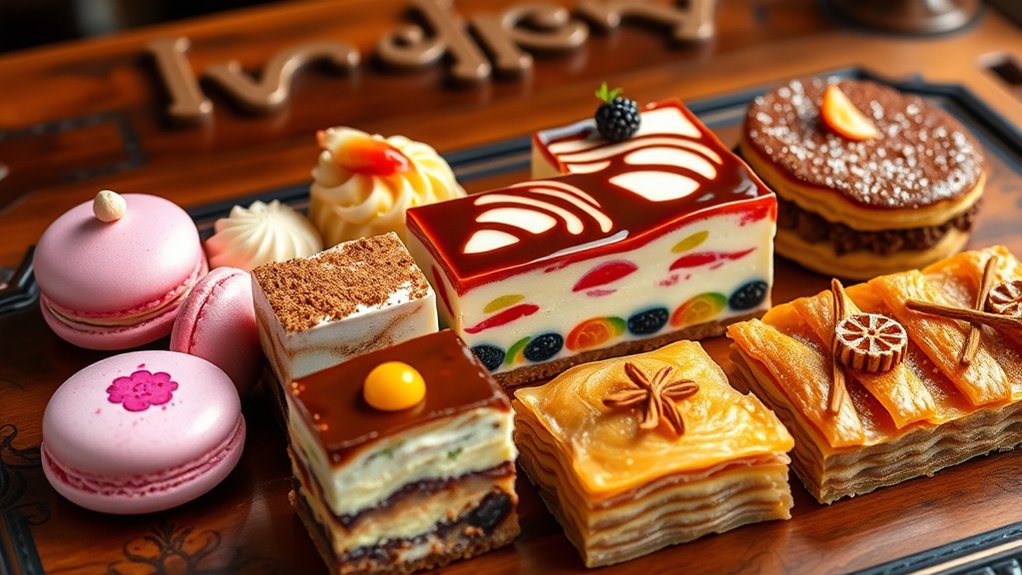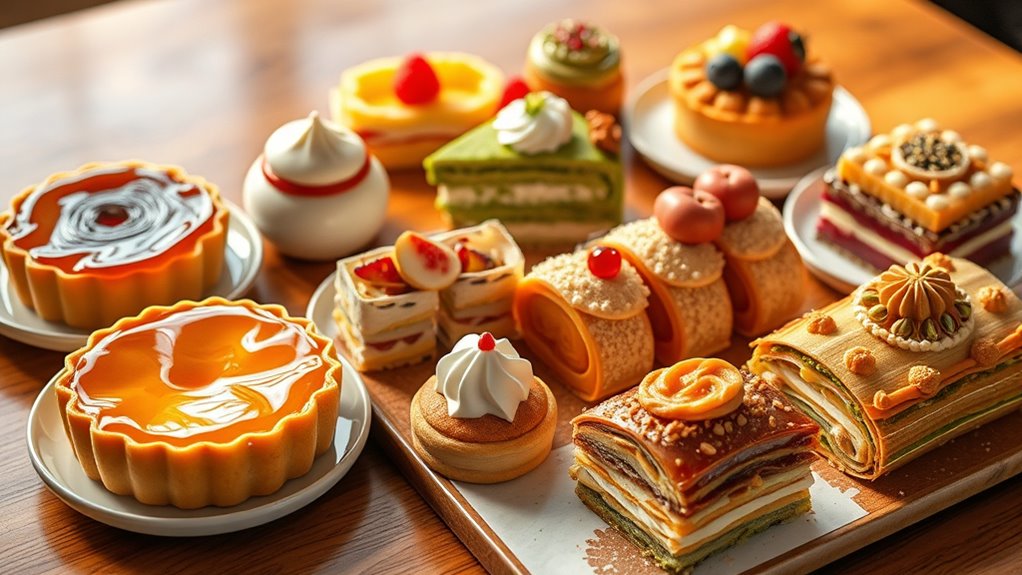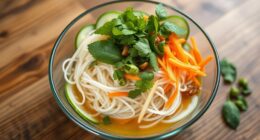Exploring desserts worldwide lets you see how each culture’s history, ingredients, and traditions shape sweet treats that tell their own stories. From French crème brûlée’s elegance to Italian tiramisu’s bold flavors, each dessert offers a taste of regional pride. Asian sticky rice desserts highlight tropical ingredients, while Middle Eastern baklava showcases nutty richness. Continuing this journey will uncover how land and history influence the world’s most beloved confections and deepen your appreciation for global flavors.
Key Takeaways
- Desserts reflect each culture’s history, ingredients, and land, offering insights into regional traditions and culinary practices.
- European sweets like crème brûlée and tiramisu showcase regional flavors, presentation, and cultural elegance.
- Asian sticky rice desserts, such as Thai mango sticky rice, highlight tropical ingredients and harmony of flavors.
- Japanese sweets like mochi emphasize seasonal, refined ingredients and cultural significance in celebrations.
- Middle Eastern and Latin American desserts, like baklava and dulce de leche, illustrate local resources and traditional flavor profiles.

Desserts around the world showcase an incredible variety of flavors, textures, and traditions that reflect each culture’s unique history and ingredients. When you explore these sweet treats, you’re not just tasting something delicious—you’re experiencing a piece of the culture that created it. From the rich, creamy custards of France to the sticky, sweet rice dishes of Asia, each dessert tells a story about the people and the land they come from.
Your journey through these confections reveals how history, geography, and local ingredients shape culinary traditions, giving you a deeper appreciation for the diversity of global flavors.
Exploring global desserts uncovers how history and ingredients craft diverse culinary traditions worldwide.
As you try a French crème brûlée, you immediately notice the contrast between the smooth custard and the crisp caramelized sugar topping. This dessert embodies French elegance and precision, emphasizing quality ingredients like vanilla beans and egg yolks.
Meanwhile, in Italy, you might indulge in tiramisu, a layered coffee-flavored dessert that combines mascarpone cheese, ladyfingers, and a dusting of cocoa powder. Tiramisu reflects Italy’s love for bold coffee flavors and the art of balancing sweetness with a hint of bitterness.
Both desserts reveal how regional preferences influence ingredient choices and presentation styles, making them uniquely Italian.
Venturing into Asia, you encounter sticky rice desserts like Thai mango sticky rice. The blend of sweet coconut milk, ripe mango slices, and glutinous rice creates a harmonious balance of flavors and textures that highlight tropical ingredients.
These desserts often emphasize fresh, natural flavors and simple preparation methods, rooted in centuries of traditional practices.
In Japan, mochi offers a chewy, versatile treat made from glutinous rice pounded into a sticky dough. Mochi’s subtle sweetness and chewy texture showcase Japan’s appreciation for delicate, refined sweets that complement seasonal celebrations.
Exploring how traditional ingredients influence dessert flavors reveals the importance of local resources and culinary heritage in shaping regional sweets.
Heading to the Middle East, you might savor baklava, a layered pastry filled with chopped nuts and soaked in honey or syrup. Its flaky texture and sweet, nutty flavor reflect the region’s rich history of pastry making and abundant use of nuts and honey.
Similarly, in Latin America, you could enjoy dulce de leche—a caramel-like spread made from slowly cooked milk and sugar—highlighting local dairy traditions and the importance of caramelized flavors in regional desserts.
Frequently Asked Questions
What Are the Origins of Popular International Desserts?
You’re curious about where popular international desserts come from, right? Many desserts have rich histories tied to their cultures. For example, Italy’s tiramisu blends coffee and mascarpone cheese, rooted in Venice’s love for coffee and layered flavors.
France’s éclairs originated from pastry chefs experimenting in Paris. These desserts often reflect local ingredients, traditions, and historical influences, making each sweet a delicious story of its cultural origins.
How Do Desserts Reflect Cultural Traditions and History?
You see that desserts often mirror a culture’s history and traditions. They incorporate local ingredients, reflect religious beliefs, and celebrate seasonal events.
For example, European desserts might showcase centuries-old recipes passed down through generations, while Asian sweets often symbolize prosperity or good luck.
Are There Dietary Restrictions Associated With Specific Global Desserts?
Imagine a world where every sweet treat tells a story. Many desserts reflect dietary restrictions—like halal or kosher laws, which ban certain ingredients, or vegan options that exclude dairy and eggs.
Some desserts, such as gluten-free cakes or sugar-free candies, cater to health needs. You’ll find that global desserts adapt to cultural, religious, and health considerations, making each one a delicious reflection of its unique traditions and restrictions.
How Do Regional Ingredients Influence Dessert Variations Worldwide?
Regional ingredients greatly influence dessert variations worldwide, shaping flavors and textures you experience. You’ll notice that local produce, spices, and staples like rice, beans, or coconut are incorporated into traditional recipes, giving each dessert a unique identity.
For example, tropical fruits add freshness in the Caribbean, while nuts and honey are prominent in Middle Eastern sweets. These ingredients reflect local climates, agriculture, and cultural preferences, making each dessert a delicious expression of its region.
What Modern Trends Are Shaping Traditional Dessert Recipes?
You might think traditional desserts remain unchanged, but modern trends are transforming them. You see chefs experimenting with plant-based ingredients, reducing sugar, and incorporating global flavors like matcha or turmeric.
This fusion keeps classic recipes fresh and relevant, appealing to health-conscious and adventurous eaters.
Conclusion
As you’ve traveled through these sweet landscapes, you’ve seen how desserts are like windows into each culture’s soul, each one telling a story of history, tradition, and passion. Just as a mosaic forms a vibrant picture, these treats unite us in shared delight and curiosity. So next time you indulge, remember—you’re tasting a piece of the world’s heart, a delicious journey that connects us all, one bite at a time.









